1997 PONTIAC GRAND AM window
[x] Cancel search: windowPage 32 of 371
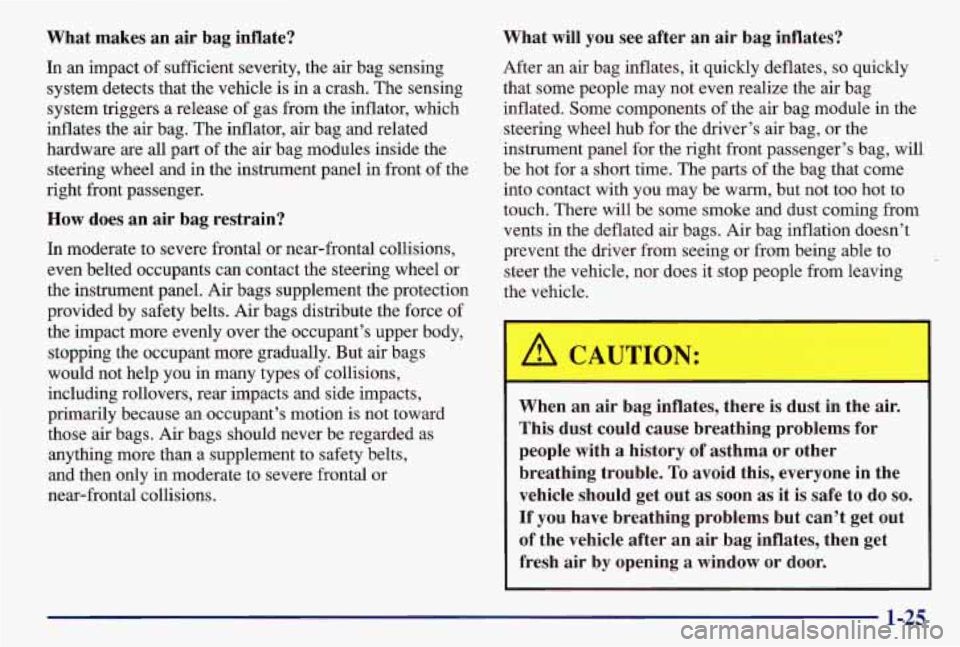
What makes an air bag inflate?
In an impact
of sufficient severity, the air bag sensing
system detects that the vehicle is in a crash. The sensing
system triggers a release of gas from the inflator, which
inflates the air bag. The inflator, air bag and related
hardware are all part
of the air bag modules inside the
steering wheel and in the instrument panel in front
of the
right front passenger.
How does an
air bag restrain?
In moderate to severe frontal or near-frontal collisions,
even belted occupants can contact the steering wheel or
the instrument panel. Air bags supplement the protection
provided
by safety belts. Air bags distribute the force of
the impact more evenly over the occupant’s upper body,
stopping the occupant more gradually. But air bags
would not help you in many types
of collisions,
including rollovers, rear impacts and side impacts,
primarily because an occupant’s motion is not toward
those air bags. Air bags should never be regarded as
anything more than a supplement to safety belts,
and then only in moderate to severe frontal or
near-frontal collisions. What
will
you see after an air bag inflates?
After an air bag inflates,
it quickly deflates, so quickly
that some people may not even realize the air bag
inflated. Some components of the air bag module in the
steering wheel hub for the driver’s air bag, or the
instrument panel for the right front passenger’s bag, will
be hot for a short time. The parts of the bag that come
into contact with
you may be warm, but not too hot to
touch. There will be some smoke and dust coming from
vents in the deflated air bags. Air bag inflation doesn’t
prevent the driver from seeing or from being able to
steer the vehicle, nor does it stop people from leaving
the vehicle.
When an air bag inflates, there is dust in the air.
This dust could cause breathing problems for
people with
a history of asthma or other
breathing trouble. To avoid this, everyone in the
vehicle should get out
as soon as it is safe to do so.
If you have breathing problems but can’t get out
of the vehicle after an air bag inflates, then get
fresh air by opening
a window or door.
1-25
Page 34 of 371
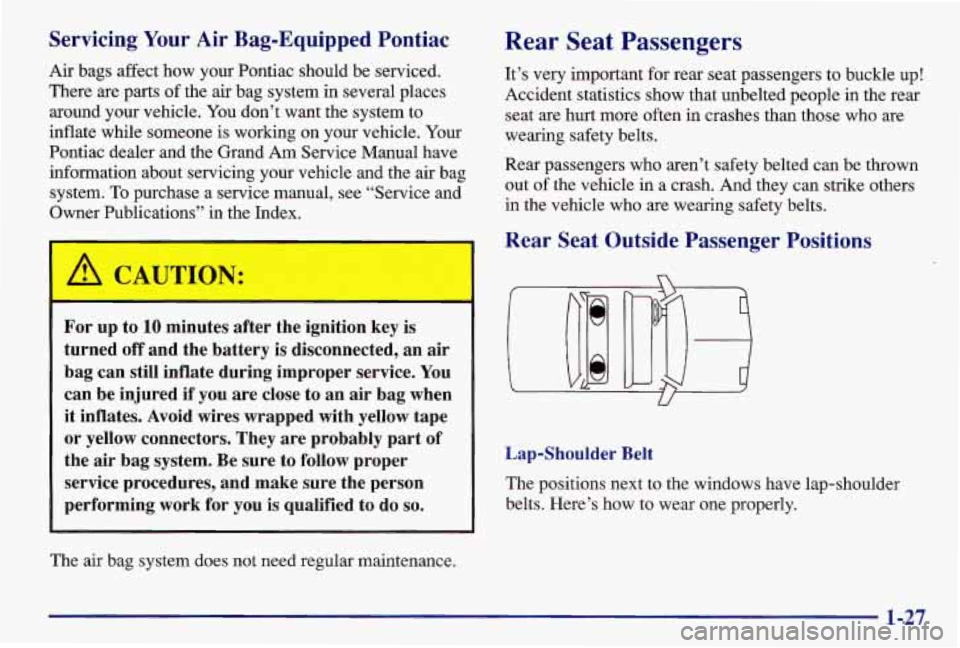
Servicing Your Air Bag-Equipped Pontiac
Air bags affect how your Pontiac should be serviced.
There are parts
of the air bag system in several places
around your vehicle. You don’t want the system to
inflate while someone is working on your vehicle. Your
Pontiac dealer and the Grand Am Service Manual have
information about servicing your vehicle and the air bag
system. To purchase a service manual, see “Service and
Owner Publications” in the Index.
I A I
/! CAUTION:
For up to 10 minutes after the ignition key is
turned off and the battery is disconnected, an air
bag can
still inflate during improper service. You
can be injured if you are close to an air bag when
it inflates. Avoid wires wrapped with yellow tape
or yellow connectors. They are probably part of
the
air bag system. Be sure to follow proper
service procedures, and make sure the person
performing work for you
is qualified to do so.
The air bag system does not need regular maintenance.
Rear Seat Passengers
It’s very important for rear seat passengers to buckle up!
Accident statistics show that unbelted people in the rear
seat are hurt more often in crashes than those who are
wearing safety belts.
Rear passengers who aren’t safety belted can be thrown
out of the vehicle in a crash. And they can strike others
in the vehicle who are wearing safety belts.
Rear Seat Outside Passenger Positions
U
Lap-Shoulder Belt
The positions next to the windows have lap-shoulder
belts. Here’s how to wear one properly.
1-27
Page 52 of 371
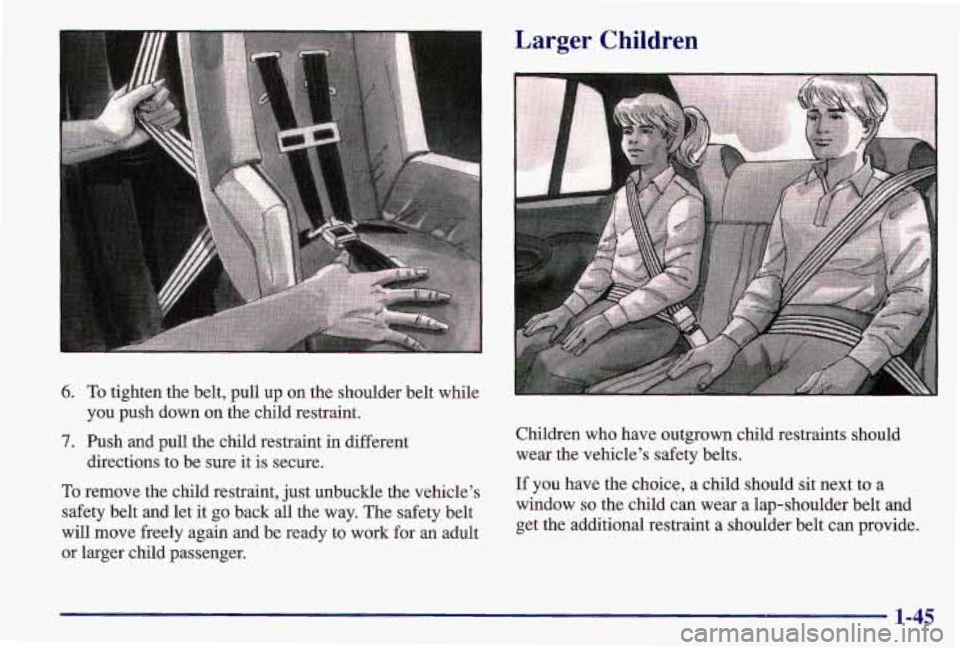
6. To tighten the belt, pull up on the shoulder belt while
you push down
on the child restraint.
7. Push and pull the child restraint in different
To remove the child restraint, just unbuckle the vehicle’s
safety belt and let it go back
all the way. The safety belt
will move freely again and be ready to work for an adult
or larger child passenger.
directions
to be sure it is secure.
Larger Children
Children who have outgrown child restraints should
wear the vehicle’s safety belts.
If you have the choice, a child should sit next to a
window
so the child can wear a lap-shoulder belt and
get the additional restraint a shoulder belt can provide.
1-45
Page 56 of 371
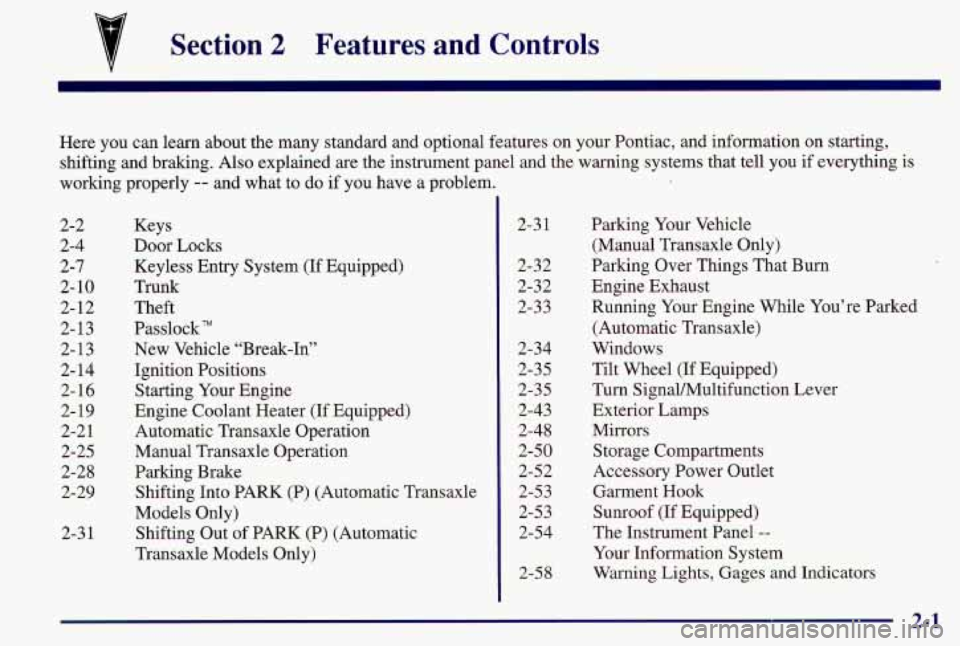
Section 2 Features and Controls
Here you can learn about the many standard and optional features on your Pontiac, and information on starting,
shifting and braking. Also explained are the instrument panel and the warning systems that tell you if everything is
working properly
-- and what to do if you have a problem.
2-2 2-4
2-7
2-
10
2-12 2-13 2-13
2-
14
2- 16
2-19
2-2
1
2-25
2-28
2-29
2-3
1
Keys
Door Locks
Keyless Entry System (If Equipped)
Trunk
Theft
Passlock
TM
New Vehicle “Break-In”
Ignition Positions Starting Your Engine
Engine Coolant Heater (If Equipped)
Automatic Transaxle Operation
Manual Transaxle Operation
Parking Brake Shifting Into PARK (P) (Automatic Transaxle
Models Only) Shifting Out of PARK (P) (Automatic
Transaxle Models Only) 2-3
1
2-32
2-32
2-33
2-34
2-35
2-35 2-43
2-48
2-50
2-52
2-53
2-53
2-54
2-58
Parking Your Vehicle
(Manual Transaxle Only)
Parking Over Things That Burn
Engine Exhaust Running Your Engine While You’re Parked
(Automatic Transaxle)
Windows
Tilt Wheel (If Equipped)
Turn SignaUMultifunction Lever
Exterior Lamps
Mirrors Storage Compartments
Accessory Power Outlet
Garment Hook
Sunroof (If Equipped)
The Instrument Panel
--
Your Information System
Warning Lights, Gages and Indicators
2-1
Page 57 of 371
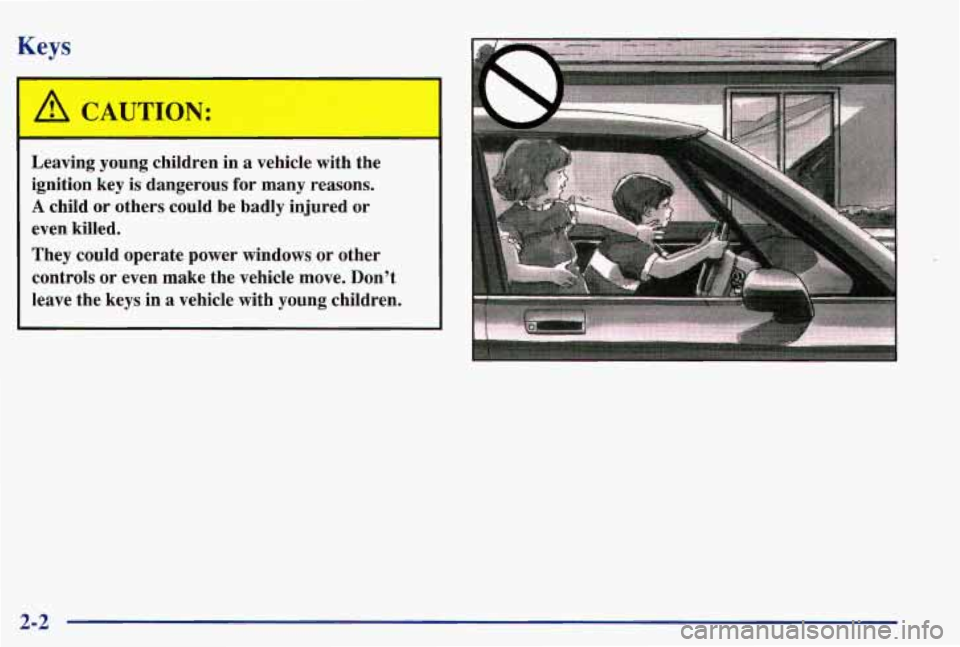
Keys
A CAUTION:
Leaving young children in a vehicle with the
ignition key
is dangerous for many reasons.
A child or others could be badly injured or
even killed.
They could operate power windows or other
controls or even make the vehicle move. Don’t
leave the keys in a vehicle with young children.
.* ...... ....... ........ >..* ..o..*..*.L..L...
2-2
Page 65 of 371
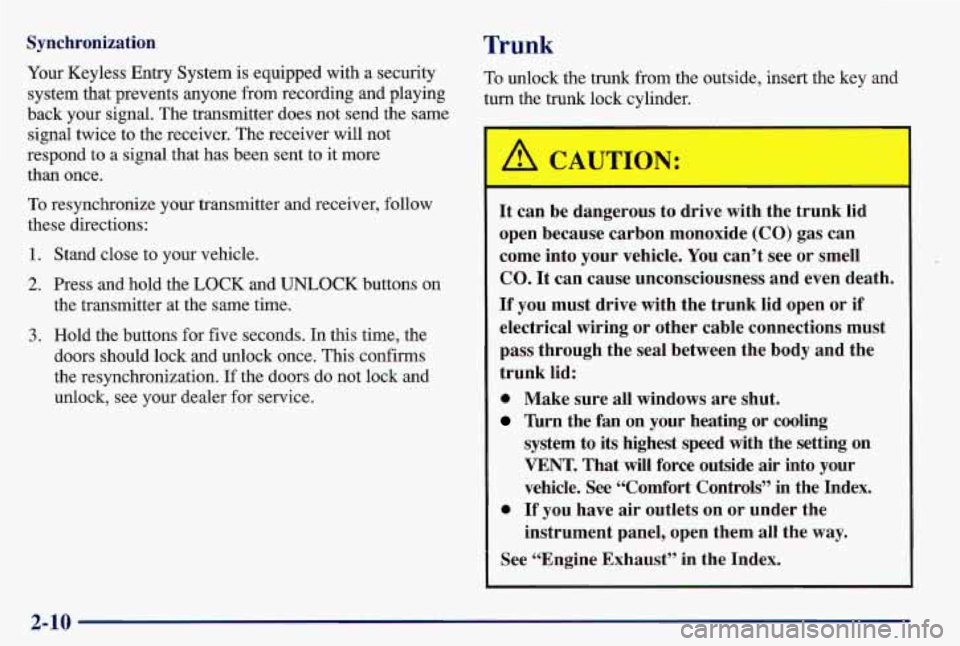
Synchronization Your Keyless Entry System is equipped with a security
system that prevents anyone from recording and playing
back your signal. The transmitter does not send the same
signal twice to the receiver. The receiver will not
respond
to a signal that has been sent to it more
than once.
Trunk
To resynchronize your transmitter and receiver, follow
these directions:
1. Stand close to your vehicle.
2. Press and hold the LOCK and UNLOCK buttons on
the transmitter at the same time.
3. Hold the buttons for five seconds. In this time, the
doors should lock and unlock once. This confirms
the resynchronization. If the doors do not lock and
unlock, see your dealer for service.
To unlock the trunk from the outside, insert the key and
turn the trunk lock cylinder.
It can be dangerous to drive with the trunk lid
open because carbon monoxide (CO) gas can
come into your vehicle.
You can’t see or smell
CO.
It can cause unconsciousness and even death.
If you must drive with the trunk lid open or if
electrical wiring or other cable connections must
pass through the seal between the body and the
trunk lid:
0 Make sure all windows are shut.
Turn the fan on your heating or cooling
system to its highest speed
with the setting on
VENT. That
will force outside air into your
vehicle. See “Comfort Controls” in the Index.
instrument panel, open them all the way.
0 If you have air outlets on or under the
See “Engine Exhaust” in the Index.
2-10
Page 67 of 371
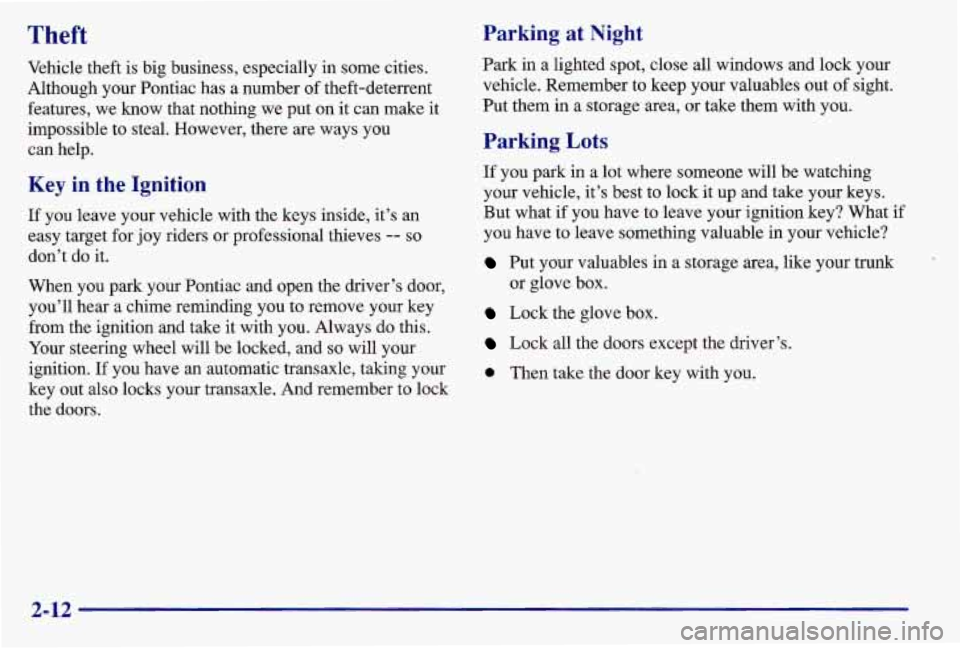
Theft Parking at Night
Vehicle theft is big business, especially in some cities.
Although your Pontiac has a number of theft-deterrent
features, we know that nothing we put on it can make it
impossible to steal. However, there are ways you
can help.
Key in the Ignition
If you leave your vehicle with the keys inside, it’s an
easy target for joy riders or professional thieves
-- so
don’t do it.
When you park your Pontiac and open the driver’s door, you’ll hear a chime reminding you to remove your key
from the ignition and take it with you. Always do this.
Your steering wheel will be locked, and
so will your
ignition.
If you have an automatic transaxle, taking your
key out also locks your transaxle. And remember to lock the doors. Park in a lighted spot, close all windows and lock your
vehicle. Remember to keep your valuables out of sight.
Put them in a storage area, or take them with you.
Parking Lots
If you park in a lot where someone will be watching
your vehicle, it’s best to lock it up and take your keys.
But what if you have to leave your ignition key? What if
you have to leave something valuable in your vehicle?
Put your valuables in a storage area, like your trunk
or glove box.
Lock the glove box.
Lock all the doors except the driver’s.
e Then take the door key with you.
2-12
Page 87 of 371
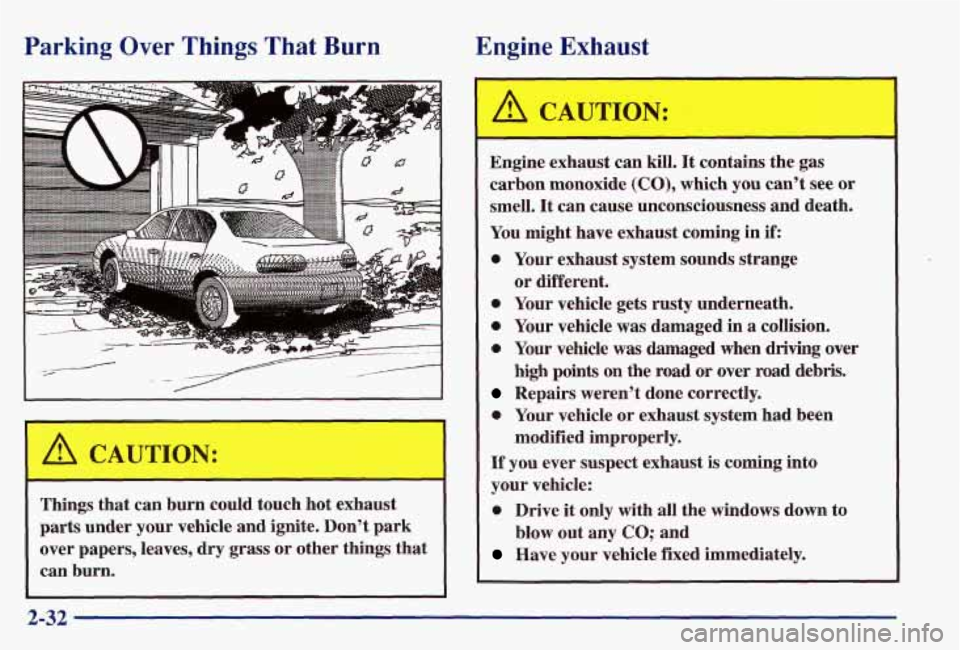
Parking Over Things That Burn Engine
Exhaust
-
Things that can burn could touch hot exhaust
parts under your vehicle and ignite. Don’t park
over papers, leaves, dry grass or other things that
can burn. Engine exhaust can
kill.
It contains the gas
carbon monoxide
(CO), which you can’t see or
smell. It can cause unconsciousness and death.
You might have exhaust coming in if:
0 Your exhaust system sounds strange
0 Your vehicle gets rusty underneath,
0 Your ,vehicle was damaged in a collision.
0 Your vehicle was damaged when driving over
high points on the road or over road debris.
Repairs weren’t done correctly.
0 Your vehicle or exhaust system had been
If you ever suspect exhaust is coming into
your vehicle:
0 Drive it only with all the windows down to
Have your vehicle fixed immediately.
or
different.
modified improperly. blow out any
CO; and
2-32